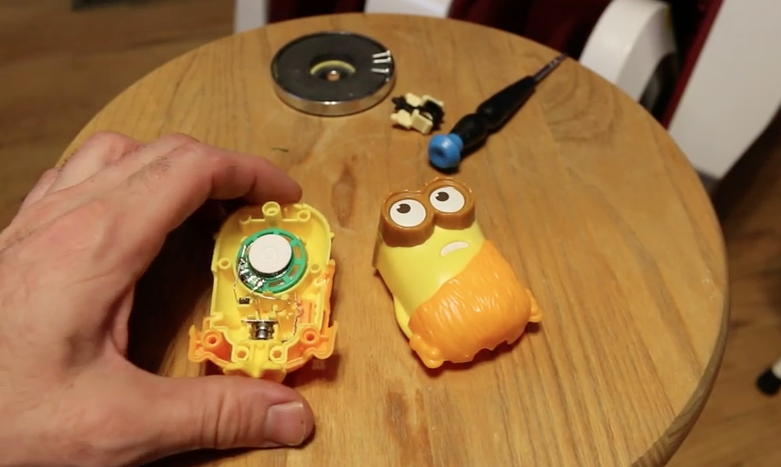
NEW YORK — McDonald’s swears up and down that the little yellow “Minions” Happy Meal toy is speaking only nonsense words and not something a little more adult.
Experts say the company may be right, and the curse words many hear may be tied to how our brains are primed to find words even when they’re not really there.
The world’s largest hamburger chain and purveyor of Happy Meals said Friday that it doesn’t plan to take the talking Happy Meal toy out of distribution, even though some customers say it sounds like it’s cursing.
A toy bought by The Associated Press made a sound that could be interpreted as the phrase often abbreviated as “WTF.” Another phrase sounded like it could be “Well I’ll be damned.” The sound quality of the toy makes it hard to say definitively who is right.
The little yellow Minion characters speak a nonsense language and McDonald’s Corp. said the Minion Caveman toy makes three sounds – “ha ha ha,” `’para la bukay,” and “eh eh.” The Oak Brook, Illinois-based company issued a statement saying it received only a few comments from customers about the toy, which was introduced July 3.
Nonsense speech will sometimes sound a bit like a real language, and experts say human brains are also wired to look for meaning in noise and images. So people will sometimes hear words in gibberish – including words they might think are inappropriate.
“The brain tries to find a pattern match, even when just receiving noise, and it is good at pattern recognition,” says Dr. Steven Novella, a neurologist at the Yale School of Medicine. “Once the brain feels it has found a best match, then that is what you hear. The clarity of the speech actually increases with multiple exposures, or if you are primed by being told what to listen for” – as most people who heard the toy online already had been.
The technical name for the phenomenon is “pareidolia,” hearing sounds or seeing images that seem meaningful but are actually random. It leads people to see shapes in clouds, a man in the moon or the face of Jesus on a grilled cheese sandwich.
The audio form of pareidolia has been causing confusion for years and years. In the 1960s the FBI investigated The Kingsmen’s version of the song “Louie Louie” after concerned citizens complained that the lyrics were obscene. The band denied it, but hardly anybody could figure out the lyrics, including the FBI. The agency officially declared the words unintelligible.
A similar phenomenon could have contributed to the belief that rock bands would put messages in their music that could only be heard by playing a record or running a tape backward.
That contributed to the “Paul Is Dead” conspiracy theory – in which the Beatles were supposedly covering up the death and replacement of Paul McCartney, but were constantly dropping hints about the cover-up in their songs – and lawsuits against heavy metal bands.
Last year a group of researchers published a paper called “Seeing Jesus in toast: neural and behavioral correlates of face pareidolia.” They wanted to understand what happens in the brains of people who see a face pop out of the toaster, and they received an Ig Nobel Prize, given to scientists who do unusual, imaginative or odd work of questionable importance.
The McDonald’s promotion is scheduled to run through the end of July. The film “Minions,” a prequel to the “Despicable Me” movies, premieres Friday. Some moviegoers will probably be listening intently to the Minions’ dialogue.
AP Writer Candice Choi contributed to this report.